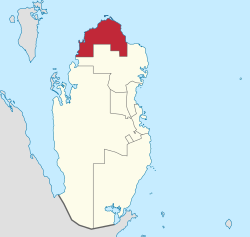Al Zubarah
|
Zubarah الزبارة Al Zubarah Az Zubarah |
|
|---|---|
| Ruined Town | |

The iconic Zubarah Fort found in Zubarah.
|
|
 Geographical location of Zubarah. |
|
 Madinat ash Shamal in Qatar. |
|
| Geographical location of Zubarah. | |
| Coordinates: 25°58′43″N 51°01′35″E / 25.97861°N 51.02639°ECoordinates: 25°58′43″N 51°01′35″E / 25.97861°N 51.02639°E | |
| Country | Qatar |
| Municipality | Madinat ash Shamal |
| Area | |
| • Total | 4.6 km2 (1.8 sq mi) |
| • Land | 4 km2 (2 sq mi) |
| Population (2010) | |
| • Total | 1,009 |
| (Includes Abu Dhalouf) | |
| Demonym(s) | Zubaran Al Zubaran |
| Official name | Al Zubarah Archaeological Site |
| Type | Cultural |
| Criteria | iii, iv, v |
| Designated | 2013 (37th session) |
| Reference no. | 1402 |
| State Party | Qatar |
| Region | Western Asia |
Zubarah (Arabic: الزبارة), also referred to as Al Zubarah or Az Zubarah, is a ruined and ancient fort located on the north western coast of the Qatar peninsula in the Madinat ash Shamal municipality, about 105 km from the Qatari capital of Doha. It was founded by Al Bin Ali , main and principal Utub tribe in the first half of the eighteenth century. It was designated a UNESCO World Heritage Site in 2013.
It was once a successful center of global trade and pearl fishing positioned midway between the Strait of Hormuz and the west arm of the Persian Gulf. It is one of the most extensive and best preserved examples of an 18th–19th century settlement in the region. The layout and urban fabric of the settlement has been preserved in a manner unlike any other settlements in the Persian Gulf, providing an insight into the urban life, spatial organization, and the social and economic history of the Persian Gulf before the discovery of oil and gas in the 20th century.
Covering an area of circa 400 hectares (60 hectares inside the outer town wall), Zubarah is Qatar’s most substantial archaeological site. The site comprises the fortified town with a later inner and an earlier outer wall, a harbour, a sea canal, two screening walls, Qal'at Murair (Murair fort), and the more recent Zubarah Fort.
It was presumably given this name due its abundance of sand and stony hillocks. During the early Islamic period, trade and commerce boomed in northern Qatar. Settlements began to appear on the coast, primarily between the towns of Zubarah and Umm al-Ma'a. A village dating back to the Islamic period was discovered near the town.
Between September 1627 and April 1628, a Portuguese naval squadron led by D. Goncalo da Silveira set a number of neighboring coastal villages ablaze. Zubarah's settlement and growth during this period is attributed to the dislodging of people from these adjacent settlements.
...
Wikipedia

